By Jim Robbins
Editor's Note: Bill Munson passed away May 19, 2000. He was one of the last of the great early American breeders using Crabbet lines. We honor him by reprinting this article from our Crabbet Influence July 1991 issue.
Ask Bill Munson (pictured in our header photo, seated on the left with Jimmy Dean on the right - at the 1983 Crabbet Symposium, Denver, Colorado. Carolyn Hasbrook photo) how he breeds horses at his Shalimar Ranch in Harrison, Nebraska, and the answer is one word: "Raffles." The pedigrees on Bill's horses read '*Raffles on *Raffles on *Raffles on *Raffles.' He has been line-breeding horses with *Raffles blood at Shalimar since 1942. As a breeder, veterinarian, and the longest recorded Big 'R' judge in history, he is eminently qualified to begin the Historic Breeders series in the Crabbet Influence.
As a player on the Iowa State University Polo Team in 1940, Bill was approached by Garth Knox (later Mrs. Buchanan) to work for her at her Bonny Croft Stables in Boone, Iowa. Little did he and Garth realize at the time that this would be the beginning for both of them of five decades of Arabian breeding and friendship. When he was at Bonny Croft, Garth purchased her first Arabian, the stallion Ragin 1284 (*Mirage x *Indaia), from the Selby Stud in Portsmouth, Ohio. Bill broke Ragin to ride and it was later, while riding Ragin, that Bill nearly lost his life and the horse drowned.
In 1942, as a graduation present from veterinary school, Garth gave Bill a trip to the Selby Stud. This trip lasted for nearly five days as Garth negotiated the purchase of Ibn Mirage 1763 (*Mirage x *Kareyma) to replace Ragin. Mr. Selby was reluctant to part with lbn Mirage as he was being kept as a replacement for his great sire, *Mirage. During their stay, Jimmy Dean, the Selby Stud manager, offered Bill the weanling colt, Selmage 2189 (Image x Selmnab). Bill was hesitant to purchase the colt as World War 11 was in full swing at this time and he felt he would soon be drafted, but Garth offered to keep the colt in the event Bill was drafted. Terms were arranged by Jimmy to meet a young veterinarian's budget. Selmage was the first Arabian Bill owned and his purchase established a friendship between Bill and Jimmy which lasted for nearly fifty years.
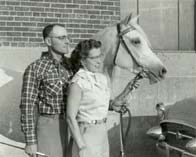
Later that same year, Cambridge, Illinois, became the new home of Dr. William Munson, D.V.M. and the Shalimar Stud was founded. In 1944, Bill and his new bride, Mae, were yet to become Arabian breeders as they were unable to acquire a mare. In those days there were less than 3,000 Arabians registered in the U.S. and it was difficult, if not impossible, to get a breeder to part with a top mare. Enter again Jimmy Dean. Jimmy had Margaret Shuey's mare Rihani 1015 (*Saoud x *Muha) in to be bred to *Raffles. Since Margaret already had a top *Mirage filly, Joharah 1620, out of Rihani, Jimmy convinced her to sell the mare to Dr. John Reardon, a friend of Bill's, so that Selmage could have a mare to breed.
SHALIMAR FOUNDATION STALLION, GARAFF
Through Jimmy Dean, Bill was later able to acquire the *Raffles son Garaff 5021 (x Woengran) and the *Raffles daughters Rafgida 4981 (x Imagida) and Wadeya 5016 (x Bambina). Garaff would prove to be the cornerstone of Shalimar, siring most of their top broodmares. Rafgida and Wadeya both produced influential daughters by Garaff. Rafgida eventually was purchased by Lois Selby Perry. Wadeya was sold to Federico Castellanos, of Cuba, in the shipment of great horses that included Rodetta 1972 (Agwe x *Roda), Julie 4804 (*Raffles x Rodetta), Charaff 5019 (*Raffles x Charmeen) and Sunny Acres Tequila 8473 (Ibn Hanad x Aeniza).
PURCHASES FROM THE DISPERSAL OF SELBY STUD
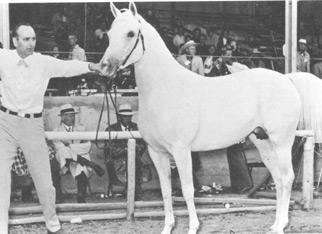
Late in 1949 postcards were mailed out from the Selby Stud announcing the dispersal of the major portion of their broodmare band. Bill and Mae were still struggling to get established at this time, so Bill went to all of his friends in Cambridge and raised the funds to purchase a group of these mares. He and Mae left the morning after the postcard arrived and were the first to get to Selby's. A deal was soon struck with Jimmy and the mares Flaia 3378 (*Raffles x Indaia), her full-sister Rafla 2073, Ylla 5020 (*Raffles x Nabima) and the aged *Kareyma 811 (Naseem x Julnar) were on their way back to Illinois. This group of mares, along with the later purchases of Collette 7703 (Rapture x Cassandra), Rose of Raswan 7154 (*Raffles x Zareyna) and the Crabbet import *Salinas 12883 (Grey Owl x Shamnar) would form the nucleus of Shalimar's mare band.
During the 1950s and 1960s, Garaff's get out of these fine mares proved the foresight of the Shalimar breeding program. The Shalimar horses were consistent winners in the show ring, brought top dollars at sales and were sought after by many of the country's finest breeders. Prominent breeders such as Garth Buchanan, Bazy Tankersley, Margaret Shuey, Albert Ehnle and Dr. James Rooker all used Shalimar breeding in their programs. Countless newcomers to the breed were fortunate enough to start their breeding programs with Shalimar-bred horses. The Munson children, Beth, Trudy, William (Bordy), and Brad also played an important part in all phases of Shalimar operations, from cleaning stalls and feeding to showing in all categories of halter and performance classes. Bill and Mae's greatest personal loss was their daughter Trudy to cancer in 1985.
THE STALLION ORBIT ARRIVES
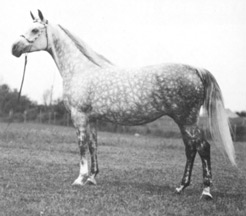
By 1960, Bill was in need of a stallion for his Garaff daughters. The search for a horse worthy of the Shalimar mares led him again to Alice Payne's Asil Arabian Ranch at Chino, California. Several years earlier, Bill had purchased from Alice the filly, Rose of Raswan, who later became U.S. Reserve National Champion Mare in 1959. At that time she had the most intensive line-bred and in-bred *Raffles based breeding program in the country. The colt Bill chose was the bay Orbit 12950 (Rafferty x Raffleeta), one of four famous brothers (Asil Apogee 16307, Syzygy 11802, Asil Ecliptic 14548, and Orbit). In the ensuing years, Orbit would be used extensively on Garaff daughters and the daughters of those matings, in turn, would often be bred back to Garaff. The result of this inbreeding strategy brought Bill one step closer to his ideal horse, which represented correct conformation, true breed type, and a sound disposition.
CHAMPIONS BRED AT SHALIMAR
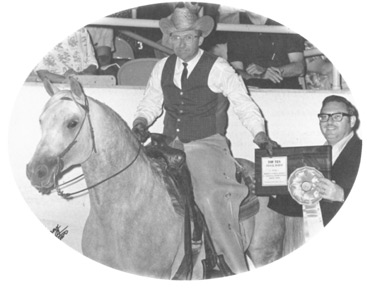
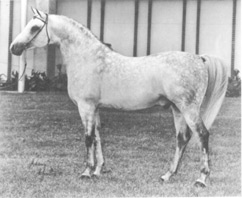
Time and space preclude a complete listing of the champions bred and shown by Shalimar over the years. Some of the highlights which must be mentioned include: Selmage winning the National Stallion Class at Waterloo, Iowa in 1947; Selmage was later the National High Point Show Horse in 1951 under the ownership of Al-Marah; Rose of Raswan, Reserve National Champion Mare in 1959; Collette, who carried the Munson children to numerous championships in both halter and performance during the 50s and 60s; Shalimar Gillette+ 17146 (Garaff x Collette), a Top Ten performance horse and Legion of Merit winner for Dr. Rooker; Shalimar Garlina+ 15854 (Garaff x *Salinas) Legion of Merit winner which in 1963 alone showed in 101 classes and received 98 ribbons for the third place AHSA High Score Award for the year, achieved in only eight shows under the capable hands of Mrs. James Rooker. Garlina's full-brother Shalimar Saligar 17144 was also a U.S. Top Ten Gelding and multi-champion performance horse. There were also Shalimar Teke 11221 (Sunny Acres Tequila x Flaia), multi-champion halter and performance stallion; the lovely Imatra 32928 (Orbit x Imra), three times Top Ten in performance; Shalimar Tarleen+ 39668 (Shalimar Tarde x Shalimar Coleen), Legion of Merit winner and multi-champion; Gwen+ 34011 (Orbit x AI-Marah Dathyna), a Legion of Merit winner and Regional Champion Driving Horse; Shalimar Tarde+ 17149 (Rasan x Rose of Raswan), Legion of Merit Winner; and Shalimar Tarzan 35180 (Shalimar Tarde x Shalimar Zifgara), multi-champion halter stallion also for Dr. Rooker. Although the show champions steal the limelight, we must not forget the dozens of Shalimar-bred horses that have become trusted riding horses and loyal companions, also representing the breeding values of Bill and Mae Munson.
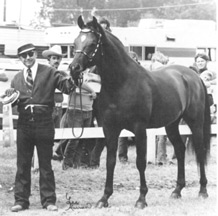
In 1972, Bill sold his veterinary practice in Cambridge, dispersed most of his broodmare band, and left with Mae for their new ranch in Harrison, Nebraska, with Garaff and Rose of Raswan in a two horse trailer behind them. This move didn't signal the end of their breeding program which continues today. Two significant farms, actively breeding and showing horses of Shalimar breeding today, are Dr. Karlan Downing's Karma Arabians, Halletsville, Texas, and Dr. and Mrs. Robert Dryden's Fable Arabians, Tucson, Arizona. The programs include not only linebred *Raffles and Skowronek horses, but also carry on Shalimar's tradition of high ethical standards.
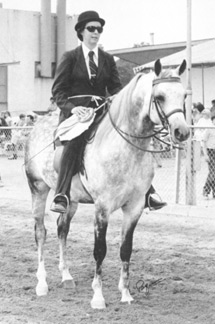
In addition to Bill's breeding and showing, few people today know that he was one of the first three Big 'R' judges named in the 50s, when the A.H.S.A first recognized the Arabian Division. The other two judges who shared this honor were the late Ward Wells, Oswego, Oregon (Crabbet.com Note: As Oregon natives, I believe this is meant to be Lake Oswego), and Don Jones of Porterville, California. Bill held his Big 'R' judging card until 1988, longer than any other Arabian judge. He is a founder and remains a trustee of the prestigious Arabian Horse Owner's Foundation. The many faceted Munson was also named a 'Builder of the Breed' by the American Shorthorn Association.
With Bill Munson's history and success as a judge, breeder, and veterinarian, we recently asked him to share his insight on five decades of Arabian horses, the colorful personalities associated with them, and thoughts on the future on the Arabian breed. The following is an excerpt of the interview conducted with Bill Munson in May 1991:
1991 JIM ROBBINS INTERVIEW WITH BILL MUNSON
Robbins: Since this issue of the Crabbet Influence is dedicated to the problems of CID, what are your opinions on this problem?
Munson: I feel that CID is a significant problem in the Arabian breed today, which is why I have a closed herd and don't risk breeding to outside stallions. I have never produced a CID foal in my inbred *Raffles horses, but I have had CID as a result of breeding to other stallions. I feel that the public absolutely has to be made aware of which horses are known CID carriers. It has to be done. But it would be a mistake to jump to any conclusions about these horses until one studies their pedigrees.
Robbins: How do you feel about the Registry's requirement to blood type all mares at $65, and the $100 registration fee for new foals?
Munson: I think it is ridiculous. None of us would complain if the blood typing was done at cost, but for an organization like the Registry to charge two to three times the cost of the service to pay for their Taj Mahal is a bunch of malarky. I have no problem with a good home for the Registry, but not at a tremendous cost to the small breeder.
Robbins: Bill, do you feel the IAHA does a competent job of promoting the breed, or do you feel their financial problems of the last decade have rendered them ineffective?
Munson: I think it has been about a break even effort - they've probably done about as much good as damage to the breed. IAHA lost it's effectiveness when it was taken from the hands of the horsemen and small breeders and given to a bunch of politicians and businessman who have lost contact with the problems of the average Arabian horse breeder.
Robbins: How do you feel about the newly created position of Judges Commissioner?
Munson: I think it's a fine idea, but who in the hell is going to pay for it? I recently received a premium from the Sioux Falls, S.D., show. On the premium list the fee was $50 for halter and performance classes, $70 for box stalls, $20 for an office fee, $10 for the IAHA Commissioner, and $5 for miscellaneous (drug testing). That's $40 per horse for nonsense charges. I don't know how the average breeder can afford to show. IAHA has just about priced the average exhibitor right out of the show market. People here are getting rid of Arabs in order to show Quarter Horses because the costs of registering and showing are a lot less expensive. I fear for the grass roots breeders; who is going to raise the gelding for endurance riding, racing, and family pleasure riding? It's almost as if we need two different breed registries - one for the rich investors and another for the everyday breeder/owner.
Robbins: Why did you give up judging in 1988?
Munson: Because I thought as a young man, "Why don't those old people give up judging when they can't even see what's going on in a class?" In 1988 I lost track of a horse in a large English Pleasure Class at a Minnesota show and decided that I was in danger of becoming one of those judges that I had complained about when I was younger.
Robbins: What type of a job do you feel judges are doing today?
Munson: I feel the young people are doing a very conscientious job of judging today, except for paying attention to tail carriage. There aren't enough horses being shown today with good, natural tail carriage. They're doing as good a job judging conformation as we did thirty years ago, it's just that they are judging to a different breed standard which is closer to the Saddlebred than the classic Arabian.
Robbins: Bill, you've judged a lot of great horses over the years. Which were some of the best mares you ever judged?
Munson: The best mare I ever saw or judged was Cassandra (*Raffles x Rodetta). I saw her first at Selby's in 1949 as a three year old when she was in for breeding. She personified to me everything an Arabian mare should be. The next time I was similarly attracted to a mare was when I saw Rose of Raswan at Alice Payne's. The best mare class I ever judged was the Pacific Coast Championship Mare class in the early 1950s. I had to decide between Cassandra (who had just weaned a foal and was thin), and Fersara (Ferneyn x Bint Sahara) who was in top shape and looked beautiful. I had to give the class to Fersara because she was a better mare in that class, but I left the ring and cried because I knew that Cassandra was the better mare.
Among my other all-time favorites would be Leland Mekeel's gorgeous chestnut mare Ghazna (Chepe-Noyon x Ginnyya); Islama (Islam x Nahshan), a lovely bay mare owned by Ross Peterson; The Cedardell mares Lallegra (Imaraff x Bint Abu) and Imarfa (Imaraff x Marifa), two of the finest mares ever bred; Henry Babson's great Fa-Ghagaha (*Fadl x *Bint Serra 1); and the John Rogers *Serafix mares were a wonderful bunch.
Robbins: What about stallions?
Munson: El Nattall (Alla Amarward x Natta). Alice Payne almost disowned me for liking that horse. Raffon (Gazon x Vadraff) would be near the top of my list; Khemosabi (Amerigo x Jurneeka); El Hadiyi (*Ansata Ibn Halima x *Sammara); Halin (*Ansata Ibn Halima x Bel Lindah), I loved that horse; Classy McCoy (The Real McCoy x Sahara Star); and El Raffon (Raffon x El Louisa).
Robbins: Who in your opinion had the best broodmare bands during the 1950s and 60s?
Munson: In no particular order: Alice Payne (Asil Arabians); Margaret Shuey (Sunny Acres); Bazy Tankersley (Al-Marah); Henry Babson (Babson's Arabian Farm); Dan Gainey (Gainey Fountainhead Arabians); R.B. Fields (Bent River Ranch); Frank McCoy (McCoy's Arabians); Garth Buchanan (Comar); Tish Hewitt (Friendship Farms); Warren Buckley (Cedardell Farms), and myself.
Robbins: Bill, which of your own horses were your favorites?
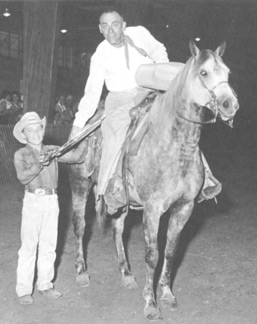
Munson: Garaff. He did a great job for us as a broodmare sire and was a good performance horse in his day. Orbit was real important to us, he was a wonderful sire and surprisingly was a good halter horse with smooth natural action. Collette was the greatest horse I ever put a saddle on. If I'd only been able to own one horse in my life I would have wanted it to be Collette. At Shalimar today two of the best fillies on the place go back to her. I couldn't have asked for a better riding mare or a better producer than Collette.
Rose of Raswan was the best show mare I ever owned. She was only beaten once or twice in her whole show career. By the time she was five or six years old Alice Payne got so tired of hearing me tell her that she was the best mare in the world that she flew into Illinois to see for herself. Now Alice had a way of standing with her hand on her hips, her feet spread apart and she would memorize every hair on a horse. So there Alice stood, hands on hips, looking at Rose. She completely circled the mare, stopping every couple of feet, and when she got to the other side she looked at me and said, "Bill, you're right, she's the best mare in the world."
Robbins: What horses do you wish you hadn't sold?
Munson: Sunny Acres Tequila and his son Shalimar Teke. At the time I sold those horses I wasn't much interested in using Polish breeding (Tequila was out of the early Polish import *Aeniza) but looking back on it I realize that *Aeniza was probably one of the finest mares ever brought into this country. I also regret selling Ylla who turned out to be a wonderful producer for Al Ehnle.
Robbins: What qualities do you look for in a broodmare?
Munson: I would put both pedigree and conformation at the top of the list. A mare has to have a good pedigree to breed on, but without good conformation there is no point in breeding on. The horse needs a good shoulder and withers, because you can't ride and use a horse that doesn't have good withers. It absolutely has to have good straight legs, natural tail carriage and a good length to hip and croup. Equally important, and indispensable is breed type, quality and disposition.
Robbins: If you could change anything about the breed today, what would you like to correct?
Munson: I'd like to take away all the malarkey that has developed over the last twenty years of showing horses and start all over again. Whip abuse came about because judges allowed it to happen. When you come down to nitty gritty, judges have allowed most of the breed problems to happen. If they had put a stop to the whip problem in the early 70s by excusing persons who abuse their horses, we wouldn't have that problem today.
The English Pleasure and Park classes today look like Saddlebred classes. If the judges had done away with all the high action, hopping, skipping, jumping at corners and all the four-beat trotters and instead had rewarded those who showed a strong two-beat trot with rhythmic, smooth even gait we would still have a true English Pleasure horse today. I've seen horses win National Champion Park Classes with four-beat trots that made me cringe. Unfortunately, there is a whole new generation out there who grew up under this new system. The change in conformation and movement first started back in the late 1960s when the 'new park horses' came into existence. From that time on the breed has evolved toward the standard of the Saddlebred and away from that of the Arabian. This could prove to be the downfall of the Arabian as a breed.
Robbins: You have had a chance to know on a personal basis some of the legendary people involved with the breed. Often the people who breed horses seem more memorable than the horses themselves. Would you share your personal insights about some of these people, such as Roger Selby, Alice Payne, Carl Raswan and Jimmy Dean?
Munson: On Carl Raswan: "He was and still is the ultimate authority on Arabian horses through his Raswan Index. He had faults and limitations like anyone else, and was judged harshly by some people for them, but his breeding theories and the history of the Arabian as he wrote it have been proven correct time after time."
On Alice Payne: "Alice Payne was the most honest Arabian horse breeder ever. She was a true breeder in that she picked a type and a bloodline and stuck with them. She demanded perfection with her own horses, as she did with others, and didn't hesitate to point out a horse's faults whether it was her own or someone else. One of my favorite Alice stories was when I took her to Cedardell Farms in the early 1960s. At that time they had the National Champion mares Lallegra and Imarfa and the National Champion Stallion Synbad. Mr. and Mrs. Buckley were present at the time because 'the' Alice Payne was coming to see their horses. Red Beyer, their trainer, brought out horse after horse and Alice ripped them to shreds in front on the Buckleys. I was madder than hell after that and told her I would never take her to another farm again. So a couple of years went by and she started badgering me to go and see Dr. La Rue's horses. I kept putting her off and telling her no, because the La Rues didn't have any children and thought of those horses as their kids. Finally agreed to take her on the condition that she didn't say one word about their horses.
They proceeded to bring out every horse on the place for Alice to see and she didn't say one single word. By the time we'd looked at twenty five horses and Alice hadn't said anything the La Rues were almost in tears. I was dying of embarrassment and all Alice did was stand there with her hands on her hips. Finally Carolyn Gardner, their trainer at the time, brought out the last horse, Harod. At this time Alice believed that horses should be shaped like rectangles on their sides (Ed. Note: horizontal rectangle), and Harod was shaped like anything but that. So I turned to Alice and said: "Alice, do you think this horse is shaped like a rectangle?" knowing full well he wasn't. Alice couldn't help herself and blurted out, "Yes, up and down." Realizing then that I'd tricked her into saying something, she said "Goddam you Bill," and stomped off to the car."
On Roger Selby: "Mr. Selby was a hard man to get close to. I don't think he and Jimmy Dean ever became close, even after all the years that Jimmy had been at Selby's. He was a very polite man to be around, but kept his distance about everything except the horses. He did import and breed some of the greatest Arabs of this century."
On Jimmy Dean: "I loved Jimmy Dean. He was the greatest public relations man in the history of the breed. Although he could violently disagree with people about horses, he would never say anything unkind to people to hurt their feelings. We had entirely different breeding programs but could and did respect each other's horses. Jimmy would often come and spend two or three days at the ranch and never mention the word 'horses.' Jimmy's passing was a great loss to the Arabian breed but even a greater loss to those who knew him."
Robbins: Bill, fifty years from now what would you like to be remembered for?
Munson: The Shalimar mares. I think I'll be remembered because these mares will breed on and on. I bred well enough and tight enough in pedigree that even with two or three out crosses they won't disappear. I wish you could see our fillies from last year's foal crop. They look like peas in a pod - typey, leggy, correct, pretty heads, good dispositions and they've been bred this way through seven generations.
*************************************************************
From the 1991 issue
About Jim Robbins:
When Jim was eleven he saw a photograph of Shimmering Star (Syzygy x Lalla Kadija) and knew that was the type of Arabian he wanted to breed someday. Four years later he had saved enough money washing dishes after school to make payments on his first Arabian, purchased from Dick and Carolyn Hasbrook of Twinbrook Arabians. The Hasbrooks' Crabbet-based breeding program and their friendship fostered Jim's interest in learning everything he could about the early *Raffles breeding programs. Through many hours of research, study and conversation, Jim has gained a substantial working knowledge of why those programs have succeeded and hopes to share the history and opinions of those early breeders with you.
Today Jim breeds Arabians in Portland, Oregon, and his stallion, Shah Zoom (Ansata Shah Zaman x Infinite), is out of Shimmering Star's full-sister. The mare band at his R-Farm includes three mares from Friendship Farm: Dancing Gem (Raffi x Geybima); Participate (Llano Grande Conquistador x Paragon), Chimes (Firebrand x Campana) who is on lease from Mrs. Hewitt. The two mares completing the band are the Rifage bred Royal Roseate (Rifik x B. Wyoma Rose) and his 'out cross mare' P.R. Munequita (*EI Shaklan x Ramishka).
**All of the articles included in the re-launched Crabbet.com site from the original website, Georgia Cheer, Silver Monarch Publishing and The Crabbet Influence magazine are shared here with permission of Georgia Cheer given May 16, 2012.**
Last Updated: March 19th, 2019

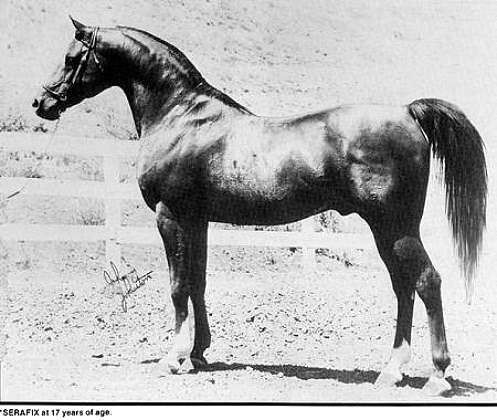
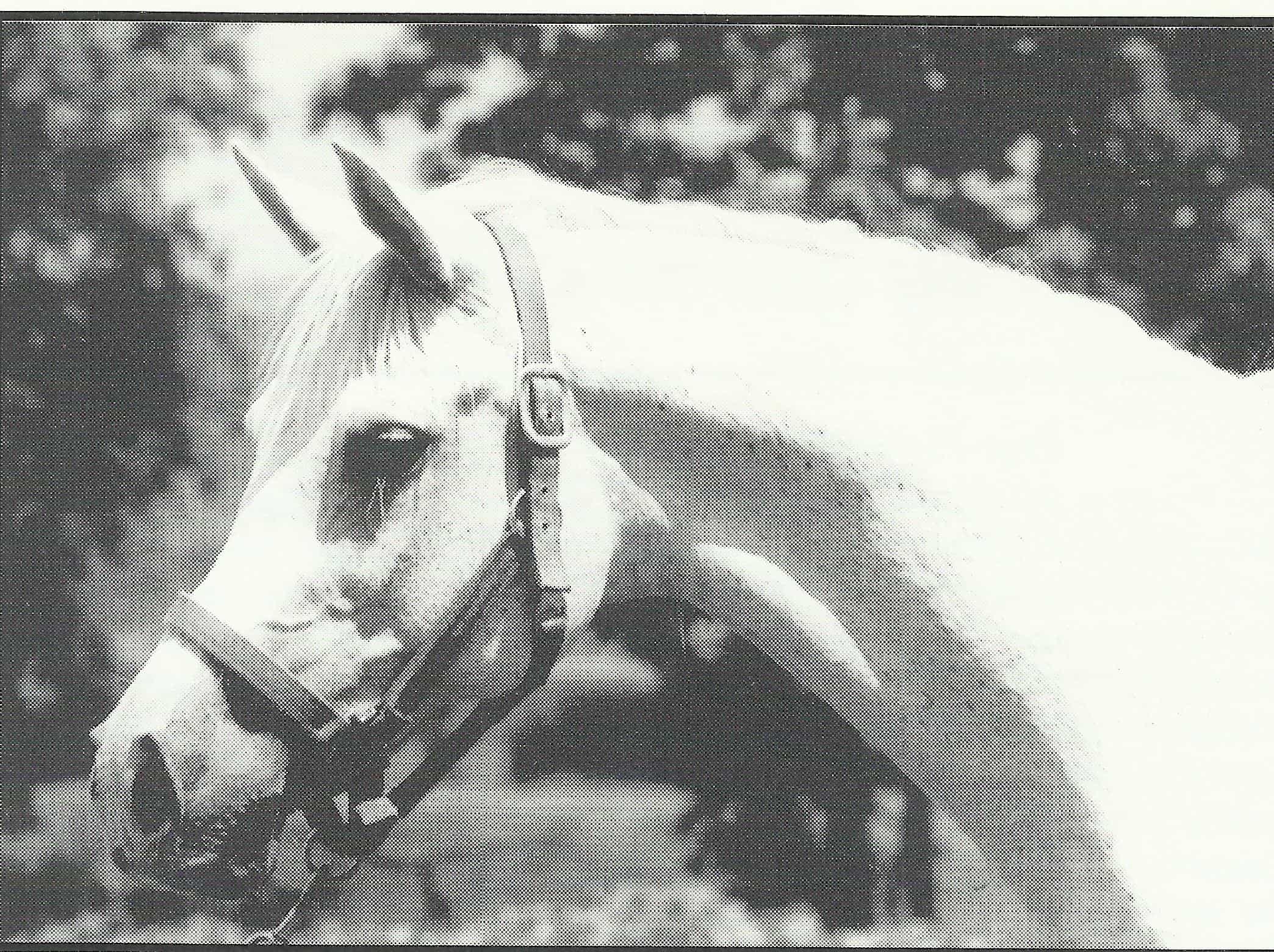

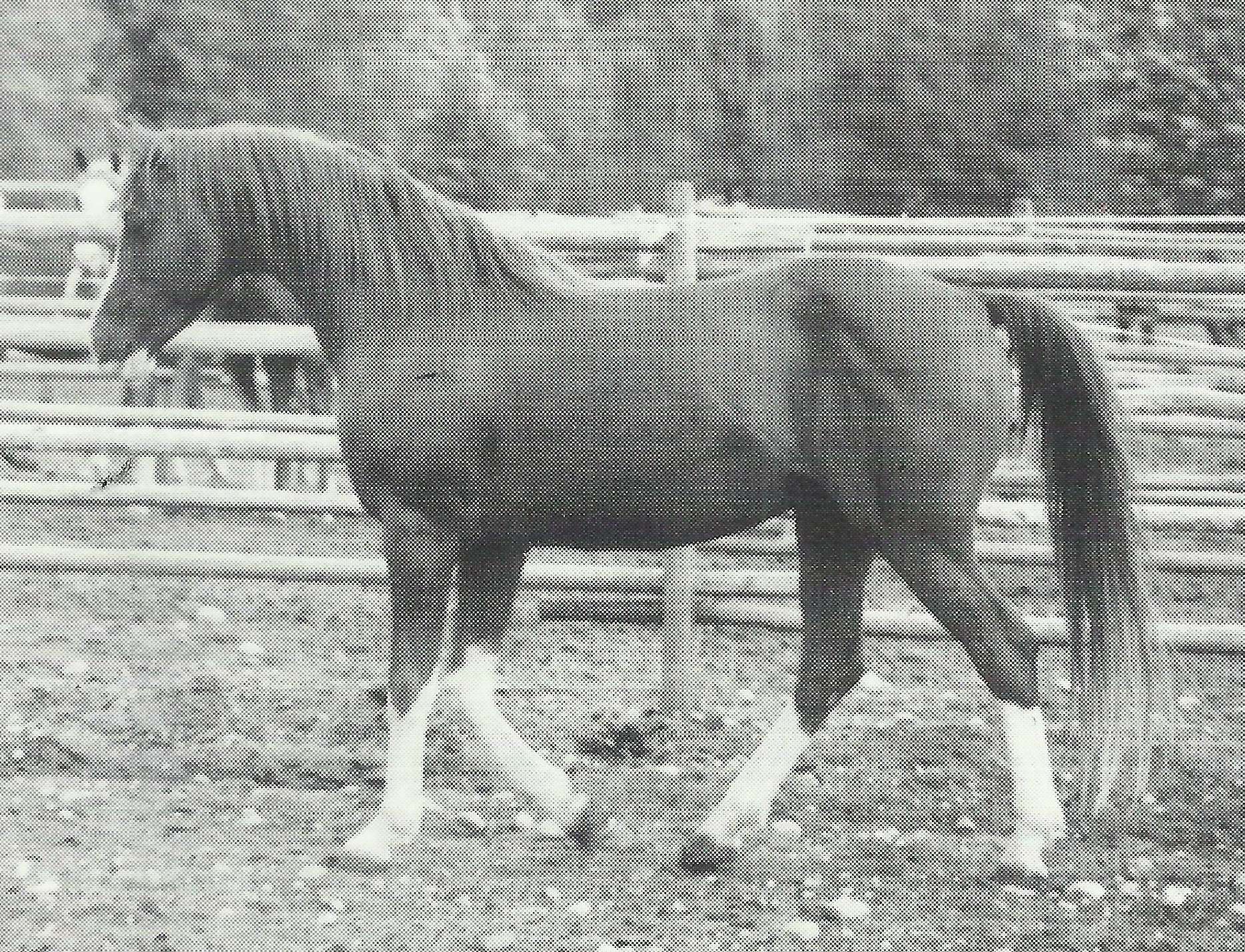
Comments
No Comments